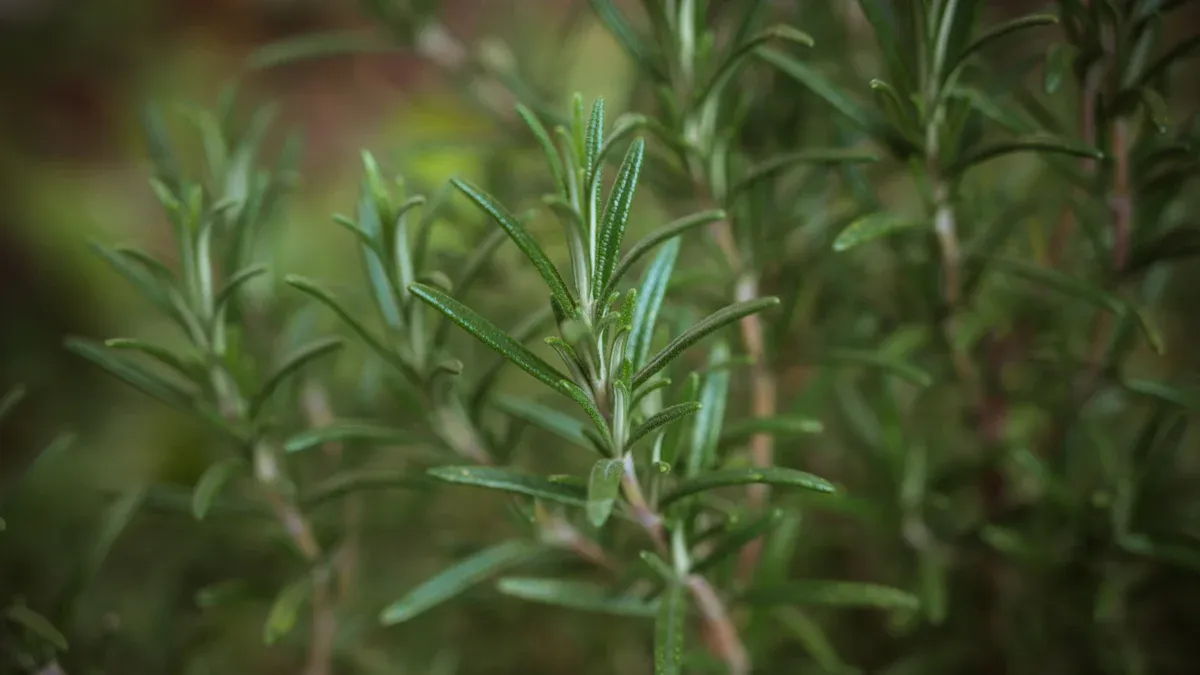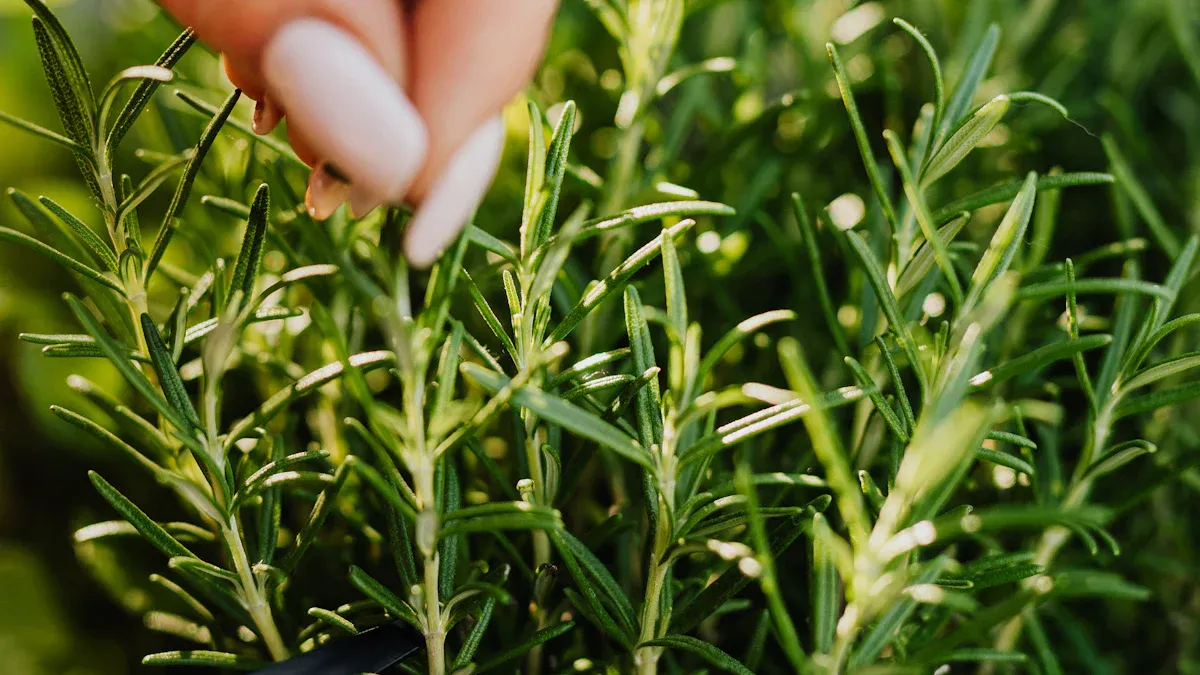
Companion plants play a vital role in gardening. They help boost the growth and flavor of your plants. When it comes to rosemary, several companion plants can enhance its health and productivity. Consider pairing it with thyme, sage, or marigold for the best results. These companion plants not only thrive together but also create a flourishing garden environment.
Key Takeaways
Pair rosemary with thyme, sage, or marigold to boost growth and flavor.
Use companion plants for natural pest control, enhancing the health of your garden.
Create a balanced ecosystem by combining rosemary with vegetables like carrots and pole beans.
Benefits of Companion Plants

Companion plants offer numerous benefits that can significantly enhance your gardening experience, especially when growing rosemary. Let’s dive into how these plants can boost growth and flavor, as well as provide natural pest control.
Growth and Flavor Enhancement
When you plant rosemary alongside certain companion plants, you can see improvements in both growth and flavor. For example, thyme and rosemary thrive in similar conditions, which means they can share nutrients and water effectively. This synergy can lead to healthier plants overall. While many claims about companion planting enhancing rosemary growth are based on anecdotal evidence, the idea is that these plants can create a more balanced ecosystem in your garden.
Benefits of companion planting for growth:
Rosemary can benefit from the presence of plants like sage and lavender, which may help improve its flavor.
Interplanting with vegetables like broccoli and cauliflower can confuse pests, leading to healthier plants.
The combination of rosemary with other herbs can enhance the aromatic qualities of your garden.
Pest Control Benefits
Companion plants also play a crucial role in pest control. Rosemary is known for its natural pest-repellent properties, but it’s not a one-size-fits-all solution. Pairing it with other plants can enhance its effectiveness. For instance, marigolds can deter harmful insects like aphids, creating a protective barrier around your rosemary.
Key points about pest control:
While rosemary repels certain pests, it’s wise to use a mix of companion plants for a more comprehensive pest management approach.
Studies show that intercropping rosemary with sweet peppers can significantly reduce pest populations, including spider mites and aphids.
The volatile compounds in rosemary help repel various pests, making it a valuable addition to your pest control strategy.
By creating a thriving rosemary garden with the right companion plants, you can enjoy not only enhanced growth and flavor but also a natural way to keep pests at bay. So, consider adding these companions to your garden for a healthier, more productive rosemary experience!
Top Companion Plants for Rosemary

When you think about companion plants for rosemary, several options come to mind. Each plant brings unique benefits that can enhance your garden’s health and productivity. Let’s explore some of the best companion plants for rosemary and how they can work together harmoniously.
Thyme
Thyme is a fantastic companion for rosemary. Both herbs thrive in similar conditions, such as full sun and well-drained soil. When you plant thyme alongside rosemary, you create a supportive environment that boosts their growth. Thyme has no major pest or disease problems, which means it can enhance rosemary’s natural resistances. Plus, the strong scent of both herbs helps repel pests like cabbage moths and mosquitoes.
Care Tips:
Ensure both plants receive plenty of sunlight.
Water them moderately, allowing the soil to dry out between watering.
Thyme can also benefit from the shade provided by taller rosemary plants, helping to maintain soil moisture.
Sage
Sage is another excellent companion for rosemary. This herb not only enhances the flavor of rosemary but also helps deter pests. Research shows that sage is one of the few herbs that thrive alongside rosemary, making them a perfect pairing in your herb garden.
Care Tips:
Both plants prefer well-draining soil, but sage enjoys slightly richer soil than rosemary.
Plant them together to maximize their growth potential and pest control benefits.
Marigold
Marigolds are not just pretty flowers; they also play a crucial role in pest management. When you plant marigolds near rosemary, they help repel harmful insects like aphids and tomato hornworms. This combination creates a balanced ecosystem that supports both plants.
Care Tips:
Marigolds thrive in full sun and well-drained soil, similar to rosemary.
Regular watering is essential, but be careful not to overwater, as rosemary prefers drier conditions.
Oregano
Oregano is another herb that pairs well with rosemary. Both plants share similar light and water requirements, making them easy to care for together. Oregano attracts beneficial insects and has pest-repelling properties, which help protect nearby plants.
Care Tips:
Plant oregano in well-drained, slightly acidic soil.
Allow the soil to dry out between watering to prevent root rot.
Pole Beans
Pole beans can enrich the soil with nitrogen, benefiting nearby plants like rosemary. Additionally, rosemary’s natural pest-repellent properties provide a protective effect for pole beans, making this combination a win-win.
Care Tips:
Ensure that pole beans have a trellis or support to climb.
Keep an eye on watering needs, as beans may require more moisture than rosemary.
Carrots
Carrots and rosemary make a great pair in the garden. Rosemary’s strong scent can mask the aroma of carrots, deterring pests like carrot root flies. This natural pest control method enhances the health of your carrots.
Care Tips:
Plant rosemary on the edges of your garden to avoid competition for space.
This placement allows rosemary to repel pests effectively while keeping carrots safe.
Strawberries
Strawberries benefit from being planted near rosemary. This combination not only enhances the sweetness of strawberries but also helps repel pests and prevent weed growth.
Care Tips:
Ensure strawberries receive plenty of sunlight and well-drained soil.
Regular watering is important, but allow the soil to dry out between watering sessions.
Lavender
Lavender is a beautiful addition to any garden and pairs wonderfully with rosemary. Not only does lavender attract beneficial insects, but it also repels harmful pests. Planting lavender alongside rosemary creates a habitat that supports these beneficial insects, enhancing pest control in your garden.
Care Tips:
Both plants thrive in well-drained, slightly alkaline soil.
They require full sunlight and regular watering, allowing the soil to dry out between waterings.
By incorporating these companion plants into your garden, you can create a thriving rosemary garden that benefits from enhanced growth, flavor, and natural pest control.
Companion planting with rosemary offers many benefits. You can enjoy natural pest control, improved plant health, and enhanced flavors. Here are some key takeaways:
Rosemary repels pests like cabbage moths and carrot flies.
It attracts beneficial insects, such as bees and butterflies.
This practice helps create a healthier garden ecosystem.
Try these combinations in your garden for better growth and pest resistance!
FAQ
What are the best companion plants for rosemary?
The best companions include thyme, sage, marigold, oregano, and lavender. They enhance growth and deter pests effectively.
Can I plant rosemary with vegetables?
Yes! Rosemary pairs well with vegetables like carrots and pole beans, providing pest control and enriching the soil.
How much sunlight does rosemary need?
Rosemary thrives in full sunlight, requiring at least 6-8 hours of direct sun each day for optimal growth.


